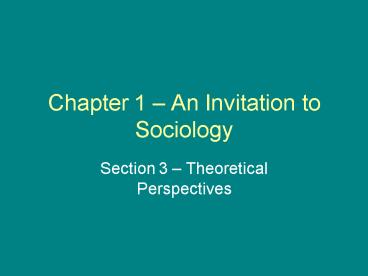Chapter 1 An Invitation to Sociology - PowerPoint PPT Presentation
1 / 15
Title:
Chapter 1 An Invitation to Sociology
Description:
Perspective is the way you interpret the meaning of an image or event ... Do you see the face of a beautiful woman? Or a cartoon of a man playing the saxophone? ... – PowerPoint PPT presentation
Number of Views:129
Avg rating:3.0/5.0
Title: Chapter 1 An Invitation to Sociology
1
Chapter 1 An Invitation to Sociology
- Section 3 Theoretical Perspectives
2
The Role of Theoretical Perspectives
- Perception is the way the brain interprets an
image or event - Perspective is the way you interpret the meaning
of an image or event - Influenced by beliefs or values you hold
- Draws you to some things and blinds you to others
3
Demonstration of Perception
- How many legs does an elephant have?
4
Demonstration of Perception
- Do you see a cube? Or a room?
- Look at it until you see both
5
Demonstration of Perception
- Do you see the face of a beautiful woman? Or a
cartoon of a man playing the saxophone? - Look at it until you see both
6
Demonstration of Perception
- Do you see a rabbit? Or a duck?
- Look at it until you see both
7
Theoretical Perspectives
- Your perspective influences what you see when you
look at the images - A theoretical perspective is a set of assumptions
about an area of study - Viewed as true by its supporters
- Three overarching perspectives in sociology
Functionalism, Conflict Theory, Symbolic
Interactionism
8
Functionalism
- Emphasizes the contributions of each part of a
society - See parts of society as an integrated whole
- Change in one part of society leads to change in
other parts - Assumes that societies tend to return to a state
of stability after some upheaval has occurred
9
Functionalism
- Most aspects of society exist to promote a
societys survival and welfare - Two kinds of functions
- Manifest functions intended and recognized
- Latent functions unintended and unrecognized
- Elements of society that have negative
consequences result in dysfunction
10
Conflict Perspective
- Opposite of functionalism
- Emphasizes conflict, competition, change, and
constraint within a society - Groups and societies compete as they attempt to
preserve and promote their own special values and
interests
11
Conflict Perspective
- Those with the most power get the largest share
of whatever is considered valuable - As the balance of power among groups in society
shifts, change occurs
12
Symbolic Interactionism
- Charles Horton Cooley and George Herbert Mead
developed the insight that groups exist only
because their members influence each others
behavior - Focuses on the actual interaction among people
13
Symbolic Interactionism
- A symbol is something chosen to represent
something else - Object, word, gesture, facial expression, sound
- Those who create and use symbols assign the
meanings to them
14
Symbolic Interactionism
- Three assumptions
- We learn the meaning of a symbol from the way we
see others reacting to it - Once we learn the meaning of symbols we base our
behavior (interaction) on them - We use the meanings of symbols to imagine how
others will respond to our behavior
15
Assignment
- Section 3 Assessment 1 3 (p. 31)
- Chapter 1 Assessment pp. 32 33
- Reviewing Vocabulary, Reviewing the Facts
- Chapter 1 QUIZ tomorrow!!































